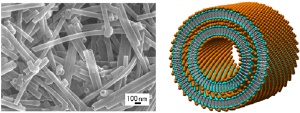Dec 3 2008
Masaki Kogiso, the Organic Nanotube Team, the Nanotube Research Center of the National Institute of Advanced Industrial Science and Technology (AIST) has developed a new technique for the mass production of unique metal-complex-type organic nanotubes. It was found that the nanotubes can be obtained when an aqueous metal salt solution is added to an alcoholic suspension of amphiphilic molecules comprising glycylglycine and fatty acids. In this process, the sheet-like structure of the amphiphilic molecules was found to change to a nanotube structure within 10 minutes. This method of synthesis has been extended to the mass production of organic nanotubes. The new technique is almost five times faster than the conventional method, and the amount obtained is 200 times that obtained in the conventional method.
 (Left) FE-SEM image of the metal-complex-type organic nanotubes and (Right) their proposed structure. Metal ion is designed as an orange ball, a hydrophilic part of the amphiphile as a light blue ball, and a hydrophobic part of the amphiphile as a gray stick.
(Left) FE-SEM image of the metal-complex-type organic nanotubes and (Right) their proposed structure. Metal ion is designed as an orange ball, a hydrophilic part of the amphiphile as a light blue ball, and a hydrophobic part of the amphiphile as a gray stick.
AIST has developed two kinds of organic nanotubes with hydroxyl groups or carboxyl groups on their surfaces, which can be mass produced. Metal-complex-type organic nanotubes, in which metal ions are present on the surface, are the third example of organic nanotubes produced in large quantities (Fig. 1).
This new class of organic nanotubes with metal ions on their inner and outer surfaces and within their membranes are expected to function as efficient catalysts because of their large specific surface areas; they can also be used to separate functional materials such as DNA and proteins. Metallic nanostructures, where nanotubes are used as templates, may find applications as electronic, magnetic, and optical materials. The organic nanotubes with metal ions are expected to be used in various fields such as medical and health care, food industry, biotechnology and electronics.
The results of this research will be exhibited at ORGATECHNO 2008, held at Tokyo Big Sight on October 28 and 29, 2008, and Nanotech 2009, which will be held at Tokyo Big Sight on February 18–20, 2009.